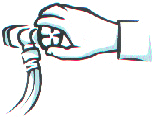Sod Maintenance for Healthy Grass
 For the first few weeks, your sod will require extra maintenance. After it's "broken in," you can gradually shift to a more relaxed maintenance schedule. At first, however follow these instructions carefully:
For the first few weeks, your sod will require extra maintenance. After it's "broken in," you can gradually shift to a more relaxed maintenance schedule. At first, however follow these instructions carefully:
- Within 1/2 hour of its installation, give the freshly applied sod at least 1 inch of water.
- For the first ten days, it's crucial that you water the new sod three times per day, during daylight. You should give the fresh turf 1/4 inch of water each time, enough that the turf and soil are kept saturated. Keep foot traffic off the new sod for these first ten days as well. This will help the turf establish itself.
- After 10 days, you can water it two times a week or four times if the weather is extremely hot and dry. This step is also crucial, even for dormant grass.
- Once the first ten days have passed, keep foot traffic and pet traffic at a minimum for the next four weeks.
- Mow your new turf as soon as sod is rooted. Make sure your mower blade is sharp and check to see that you do not cut off more than 1/3 of the blades of grass at a time.
- You may apply insecticides, if necessary, four weeks after installation. Check with your local county extension agent or garden center to determine the best choice for your lawn.
- A proper fertilization program is essential as well. Three to six applications of fertilizer a year is adequate for most turf types, and you may want a fertilizer with trace elements such as copper, iron and zinc. Our Soil Burst™ has the essential micro nutrients your grass and soil will need. Check with your local extension agent or garden center for a fertilizer recommendation and application schedule.
- The right irrigation schedule and technique can help ensure deep root growth. Soak the soil 6 inches deep when you water. This not only promotes deeper roots, it allows you to water less frequently. If you have heavy clay, soak the soil in 15 or 20 minute increments to avoid runoff. Frequent, but light, watering causes shallow root growth, which is susceptible to heat-stress and disease. Every soil type is different, and will require more or less water depending on the type. Typically, soil with a lot of clay will retain water, where as sandy soil will drain and need to be watered more frequently.
The first few weeks after your turf lawn is installed are the most critical. Follow these instructions and you'll have a healthy, thick lawn that will add to the natural beauty of your home, and will be a pleasure for years to come. Enjoy it!

